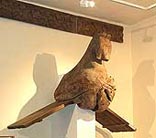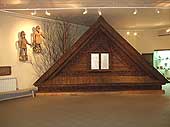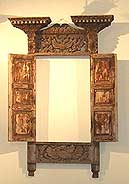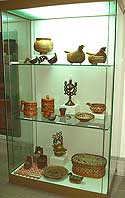The World of a Russian Village
(folk art in people’s life: rituals, traditions, feasts), (p. 1)
 The recently opened exposition “The World of a Russian Village” presents one of the most comprehensive collections of Russian folk art of the 18th – early 20th century in Russia. The numerous specimens of traditional culture help visitors to imagine folk craftsmen’s way of life and to get acquainted with the most significant rituals; family, calendar and labor feasts of a Russian village.
The recently opened exposition “The World of a Russian Village” presents one of the most comprehensive collections of Russian folk art of the 18th – early 20th century in Russia. The numerous specimens of traditional culture help visitors to imagine folk craftsmen’s way of life and to get acquainted with the most significant rituals; family, calendar and labor feasts of a Russian village.
The first hall
 The first hall presents the exterior and interior decoration of a peasant house of the late 19th – early 20th century. The rich Museum collection of architectural carving shows various techniques, compositions and images in Northern Russia and in the Volga Area samples. The fronton, made in 1882 by Mikhail Malyshev from the Nizhegorodskaya Province, is most valuable. The free interpretation and superb technique characterize M. Malyshev as one of the most talented craftsman of the Volga house architecture.
The first hall presents the exterior and interior decoration of a peasant house of the late 19th – early 20th century. The rich Museum collection of architectural carving shows various techniques, compositions and images in Northern Russia and in the Volga Area samples. The fronton, made in 1882 by Mikhail Malyshev from the Nizhegorodskaya Province, is most valuable. The free interpretation and superb technique characterize M. Malyshev as one of the most talented craftsman of the Volga house architecture.
 The peasants’ belief in the “other world” is confirmed by the frequent kind and evil images: mermaids, mermen, seirens. Nearly the whole spectrum of the mythological images and motifs of the Volga architectural carving is represented in the window-frame of the late 19th century from the Nizhegorodskaya Province. It reflects our ancient ancestors’ ideas of the world.
The peasants’ belief in the “other world” is confirmed by the frequent kind and evil images: mermaids, mermen, seirens. Nearly the whole spectrum of the mythological images and motifs of the Volga architectural carving is represented in the window-frame of the late 19th century from the Nizhegorodskaya Province. It reflects our ancient ancestors’ ideas of the world.
 The peasant house interior was determined by the tradition that passed from generation to generation. The late 19th – early 20th century interior of the Vyatka-Vologda Region is conventionally staged. Each corner of the heated part of the house had its significance and was used as a separate room. In contemporary terms, four corners corresponded to a kitchen, hall, sitting-room and bed-room. The main parts were stove and “red” corners of the house, presenting special sacral centers.
The peasant house interior was determined by the tradition that passed from generation to generation. The late 19th – early 20th century interior of the Vyatka-Vologda Region is conventionally staged. Each corner of the heated part of the house had its significance and was used as a separate room. In contemporary terms, four corners corresponded to a kitchen, hall, sitting-room and bed-room. The main parts were stove and “red” corners of the house, presenting special sacral centers.
|


